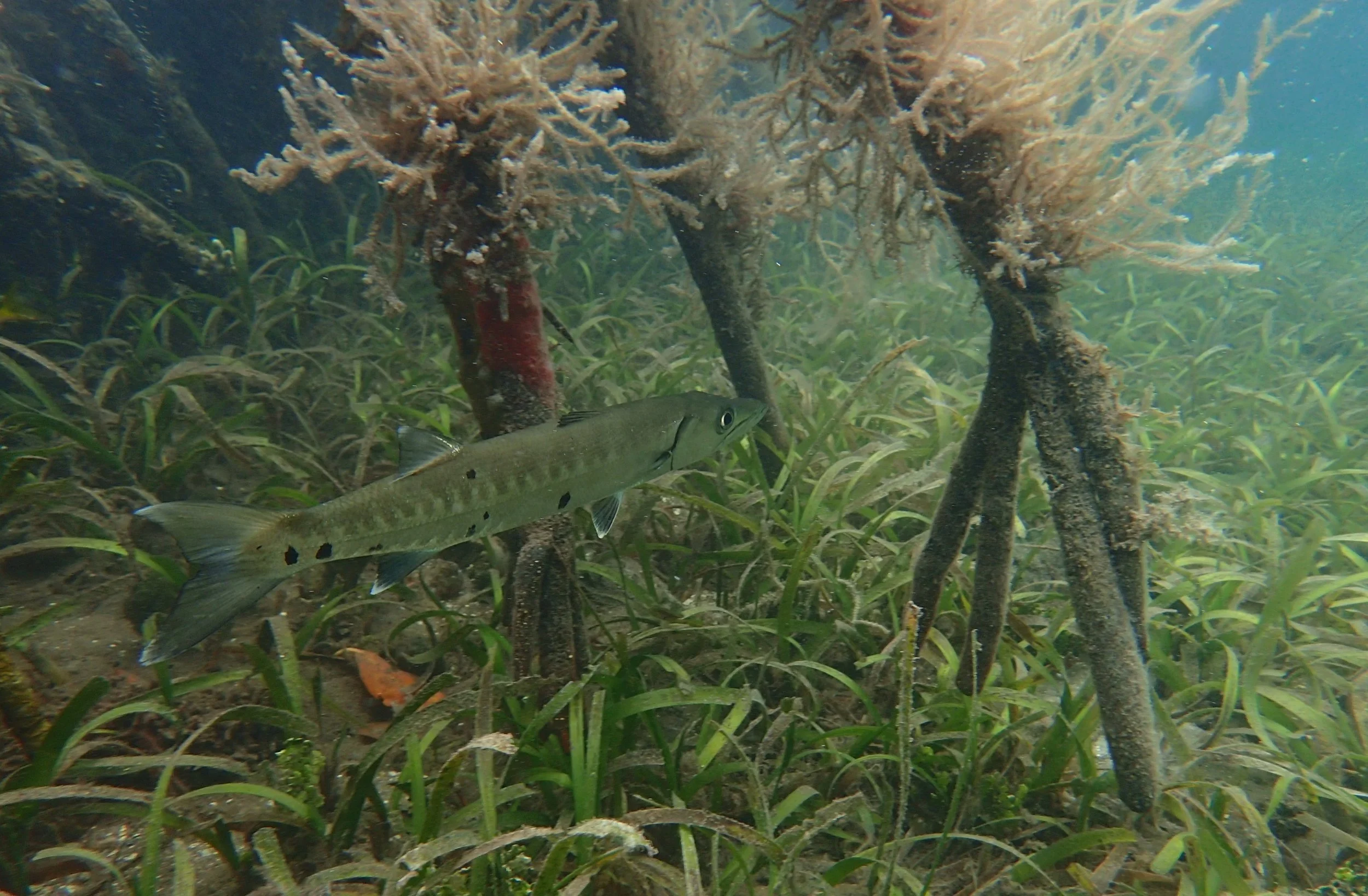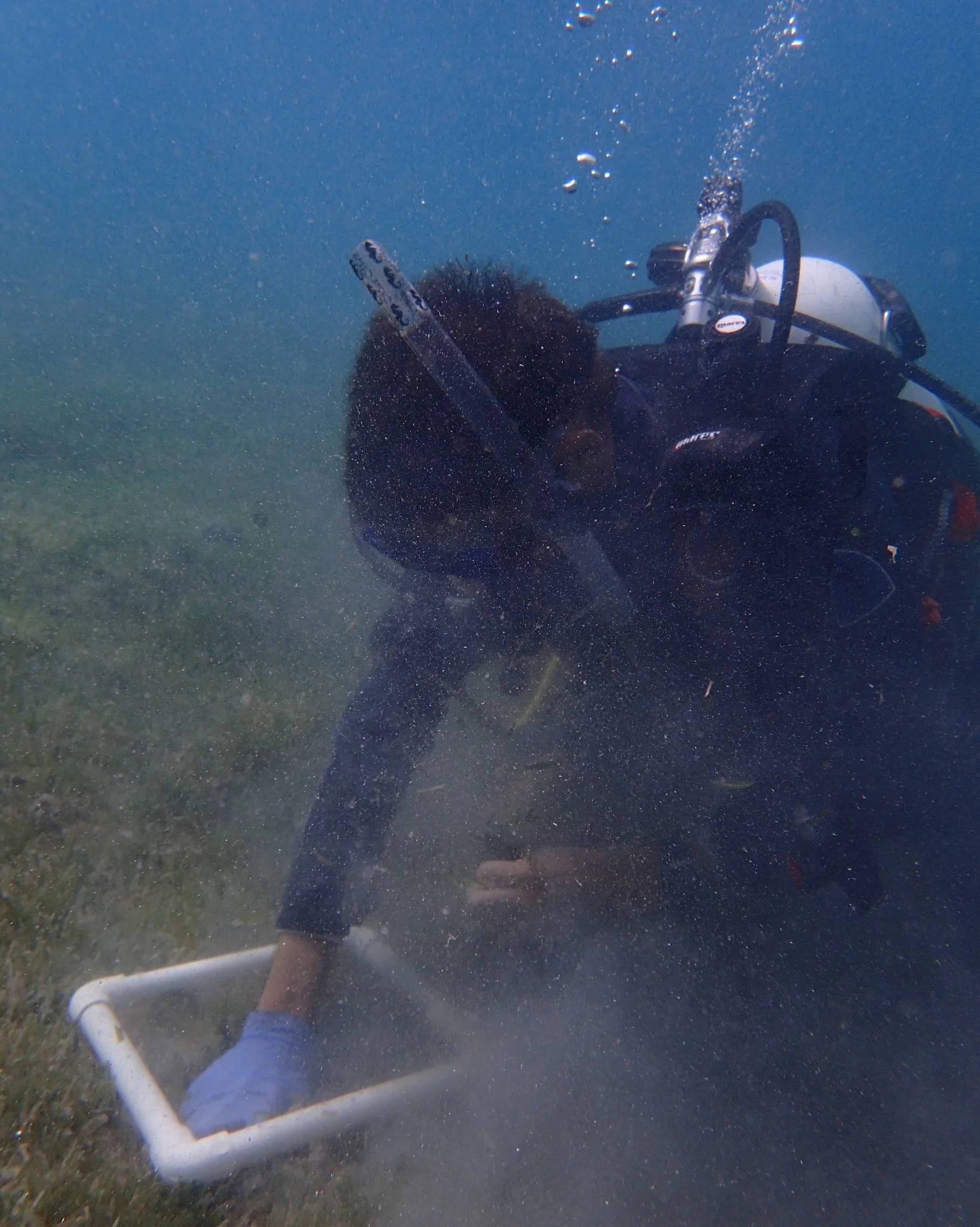What Are The Impacts of An Invasive Seagrass?
What Are The Impacts of An Invasive Seagrass
Native seagrasses play a primary role in the diet of sea turtles and provide important habitat for juvenile fishes. This juvenile green sea turtle lingers over a mixed seagrass bed with both native and invasive species
The invasive seagrass Halophila stipulacea continues to thrive in the Caribbean. Don't be surprised if you haven’t heard of it, this is a recent plant to colonize the USVI and it hasn't received a lot of attention from the public. H. stipulacea is tenacious and competes efficiently for space with native seagrasses which struggle with man-made threats (anchor dredges, pollution, nutrient run-off). Adding to the problem, few species in the Territory consume it.
Native seagrass such as Turtle Grass, Thalassia testudinum, play a primary role in the diet of green sea turtles, Chelonia mydas, and provide important habitat for juvenile fishes. Some of the fish using native seagrass beds are commercially important to local fisherman, including tarpon, parrotfish, and snapper.
Juvenile fishes like this little barracuda, hide inshore on seagrass beds until they have matured enough to venture into deeper waters.
H. stipulacea is shorter than resident seagrass, growing around 6 cm tall compared to local grasses which grow around 30 cm. Here, a juvenile Caribbean pipefish, attempts to camouflage itself in the short spears.
how does this affect marine life?
John Cassell, a third year MMES candidate at CMES, has spent the previous summer collecting data on interactions between urchins, turtles, and H. stipulacea. The University of the Virgin Islands is devoted to learning more about H. stipulacea, its impact in the territory, and on native herbivores. “Every plant has a specialized predator adapted to eat it,” John says, “but we don’t see one for this seagrass on St. Thomas.” He is concerned in particular that green sea turtles, who’s diet is primarily seagrass, do not choose to consume H. stipulacea. While sea turtles and urchins have been documented eating this invasive plant they still have a preference to native seagrass species, according to data collected at the Center for Marine Studies.
While it is theoretically possible for sea urchins to learn to like H. stipulacea, this is not expected to be the case for turtles. Juvenile turtles claim a large home range for foraging grounds, and swim back and forth between areas to feed. Sea urchins have less ability to move, usually sticking to a specific area near the rocks they call home. So if a turtle dislikes H. stipulacea in its diet, it can go somewhere else. Urchins have limited options.
Intrigued by this, John is creating a nutritional profile for H. stipulacea and hopes to be the first to publish information of this kind for the Territory. These nutrients include carbon, nitrogen, proteins, carbohydrates, and minerals. His research will provide answers to questions such as whether or not turtles know instinctively if the invasive seagrass is as nutritious as they prefer, or do they avoid it because of the taste?
Citizen Science
John’s research has and continues to include observational studies of sea turtle habits within Brewers Bay. In order to be successful, a long-term monitoring project needs to be put in place. Currently, CMES researchers and UVI Sea Turtle Club members have been continuously surveying Brewers Bay since 2013. John anticipates partnering with VI-EPSCoR’s Citizen Science team to facilitate more volunteers to help with this work.
Citizen Scientists can help create a database of trends, patterns and sea turtle activity on St. Thomas to help track their interaction with H. stipulacea and what they ultimately end up eating. Researchers depend on Citizen Scientists more and more to help with robust data collecting and large-scale projects around the globe.
“If invasive plants are eaten regularly they won’t have a huge impact to the ecosystem. However, if they have no natural predators, like the lionfish, it will grow unbounded. ”
This work is conducted under permit # DFW16040T from DPNR
John Cassell using SCUBA gear to collect seagrass for nutritional analysis at a sample location within Brewers Bay.
Close up view of leaves from Halophila stipulacea (left) and native Halophila decipiens (right). Note that H. stipulacea has longer leaf blades with a define dark line through the center
These zip-lock bags contain freshly collected seagrass, which are stored in a freezer until analyses are conducted.






